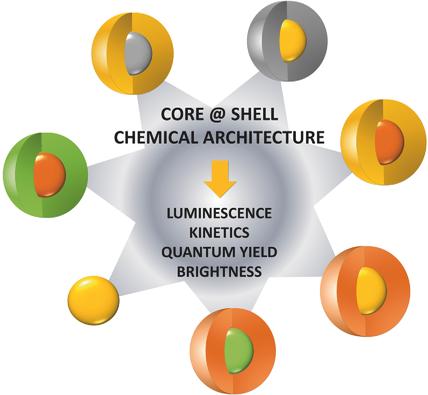Our official English website, www.x-mol.net, welcomes your feedback! (Note: you will need to create a separate account there.)
Shaping Luminescent Properties of Yb3+ and Ho3+ Co‐Doped Upconverting Core–Shell β‐NaYF4 Nanoparticles by Dopant Distribution and Spacing
Small ( IF 13.3 ) Pub Date : 2017-11-08 , DOI: 10.1002/smll.201701635 Aleksandra Pilch 1 , Christian Würth 2 , Martin Kaiser 2 , Dominika Wawrzyńczyk 3 , Michalina Kurnatowska 1 , Sebastian Arabasz 4, 5 , Katarzyna Prorok 5 , Marek Samoć 3 , Wiesław Strek 1 , Ute Resch-Genger 2 , Artur Bednarkiewicz 1
Small ( IF 13.3 ) Pub Date : 2017-11-08 , DOI: 10.1002/smll.201701635 Aleksandra Pilch 1 , Christian Würth 2 , Martin Kaiser 2 , Dominika Wawrzyńczyk 3 , Michalina Kurnatowska 1 , Sebastian Arabasz 4, 5 , Katarzyna Prorok 5 , Marek Samoć 3 , Wiesław Strek 1 , Ute Resch-Genger 2 , Artur Bednarkiewicz 1
Affiliation

|
At the core of luminescence color and lifetime tuning of rare earth doped upconverting nanoparticles (UCNPs), is the understanding of the impact of the particle architecture for commonly used sensitizer (S) and activator (A) ions. In this respect, a series of core@shell NaYF4 UCNPs doped with Yb3+ and Ho3+ ions are presented here, where the same dopant concentrations are distributed in different particle architectures following the scheme: YbHo core and YbHo@…, …@YbHo, Yb@Ho, Ho@Yb, YbHo@Yb, and Yb@YbHo core–shell NPs. As revealed by quantitative steady‐state and time‐resolved luminescence studies, the relative spatial distribution of the A and S ions in the UCNPs and their protection from surface quenching has a critical impact on their luminescence characteristics. Although the increased amount of Yb3+ ions boosts UCNP performance by amplifying the absorption, the Yb3+ ions can also efficiently dissipate the energy stored in the material through energy migration to the surface, thereby reducing the overall energy transfer efficiency to the activator ions. The results provide yet another proof that UC phosphor chemistry combined with materials engineering through intentional core@shell structures may help to fine‐tune the luminescence features of UCNPs for their specific future applications in biosensing, bioimaging, photovoltaics, and display technologies.
中文翻译:

通过掺杂剂分布和间距塑造Yb3 +和Ho3 +共掺杂的上转换核-壳β-NaYF4纳米粒子的发光性质。
稀土掺杂上转换纳米粒子(UCNPs)的发光颜色和寿命调整的核心是理解粒子结构对常用的敏化剂(S)和活化剂(A)离子的影响。在这方面,掺杂了Yb 3+和Ho 3+的一系列core @ shell NaYF 4 UCNP此处显示的离子,按照以下方案在不同的粒子结构中分布相同的掺杂剂浓度:YbHo核和YbHo @…,…@ YbHo,Yb @ Ho,Ho @ Yb,YbHo @ Yb和Yb @ YbHo核壳NP。正如定量稳态和时间分辨发光研究所揭示的那样,UCNP中A和S离子的相对空间分布以及它们对表面猝灭的保护对其发光特性具有至关重要的影响。尽管增加的Yb 3+离子量会通过放大吸收来提高UCNP性能,但Yb 3+离子还可以通过能量迁移到表面来有效地消散存储在材料中的能量,从而降低了向活化剂离子的总体能量转移效率。结果提供了又一个证明,UC磷光化学与通过有意的核壳结构进行的材料工程相结合,可能有助于微调UCNP的发光特性,以用于未来在生物传感,生物成像,光伏和显示技术中的特定应用。
更新日期:2017-11-08
中文翻译:

通过掺杂剂分布和间距塑造Yb3 +和Ho3 +共掺杂的上转换核-壳β-NaYF4纳米粒子的发光性质。
稀土掺杂上转换纳米粒子(UCNPs)的发光颜色和寿命调整的核心是理解粒子结构对常用的敏化剂(S)和活化剂(A)离子的影响。在这方面,掺杂了Yb 3+和Ho 3+的一系列core @ shell NaYF 4 UCNP此处显示的离子,按照以下方案在不同的粒子结构中分布相同的掺杂剂浓度:YbHo核和YbHo @…,…@ YbHo,Yb @ Ho,Ho @ Yb,YbHo @ Yb和Yb @ YbHo核壳NP。正如定量稳态和时间分辨发光研究所揭示的那样,UCNP中A和S离子的相对空间分布以及它们对表面猝灭的保护对其发光特性具有至关重要的影响。尽管增加的Yb 3+离子量会通过放大吸收来提高UCNP性能,但Yb 3+离子还可以通过能量迁移到表面来有效地消散存储在材料中的能量,从而降低了向活化剂离子的总体能量转移效率。结果提供了又一个证明,UC磷光化学与通过有意的核壳结构进行的材料工程相结合,可能有助于微调UCNP的发光特性,以用于未来在生物传感,生物成像,光伏和显示技术中的特定应用。



























 京公网安备 11010802027423号
京公网安备 11010802027423号